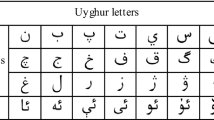Abstract
This paper describes recent work on integrating multiple strategies to improve the performance of the Mongolian historical document recognition system which utilize the segmentation-based scheme. We analyze the reasons why the recognition errors happened. On such basis, we propose three strategies according to the knowledge of the glyph characteristics of Mongolian and integrate them into glyph-unit recognition. The strategies are recognizing the under-segmented and over-segmented fragments (RUOF), glyph-unit grouping (GG) and incorporating the baseline information (IBI). The first strategy helps in correcting the segmentation error and the remaining two strategies further improve the classifiers accuracies. The experiment on the historical Mongolian Kanjur demonstrates that utilizing these strategies could effectively increase the accuracy of word recognition.
Access this chapter
Tax calculation will be finalised at checkout
Purchases are for personal use only
Similar content being viewed by others
References
Wei, H.: Study of key techniques in the printed Mongolian character recognition. Master thesis, Inner Mongolia University (2006)
Wei, H., Gao, G.: Machine-printed traditional mongolian characters recognition using bp neural networks. In: Proceedings of International Conference on Computational Intelligence and Software Engineering (CiSE), pp. 1–7 (2009)
Peng, L., Liu, C., Ding, X., Jin, J., Wu, Y., Wang, H., Bao, Y.: Multi-font printed mongolian document recognition system. IJDAR 13(2), 93–106 (2010)
Gao, G., Su, X., Wei, H., Gong, Y.: Classical mongolian words recognition in historical document. In: Proceedings of the 11th International Conference on Document Analysis and Recognition (ICDAR), pp. 692–697. IEEE Computer Society (2011)
Su, X., Gao, G., Wang, W., Bao, F., Wei, H.: Character segmentation for classical mongolian words in historical documents. In: Li, S., Liu, C., Wang, Y. (eds.) CCPR 2014, Part II. CCIS, vol. 484, pp. 464–473. Springer, Heidelberg (2014)
Sermanet, P., Chintala, S., LeCun, Y.: Convolutional neural networks applied to house numbers digit classification. In: Proceedings of 21st International Conference on Pattern Recognition (ICPR), pp. 3288–3291 (2012)
Krizhevsky, A., Sutskever, I., Hinton, G.E.: Imagenet classification with deep convolutional neural networks. Adv. Neural Inf. Process. Syst. 25, 1097–1105 (2012)
Szegedy, C., Toshev, A., Erhan, D.: Deep neural networks for object detection. Adv. Neural Inf. Process. Syst. 26, 2553–2561 (2013)
Sermanet, P., Eigen, D., Zhang, X., Mathieu, M., Fergus, R., LeCun, Y.: Overfeat: integrated recognition, localization and detection using convolutional networks. In: Proceedings of International Conference on Learning Representations (ICLR) (2014)
Kim, H.-J., Lee, J.S., Yang, H.-S.: Human action recognition using a modified convolutional neural network. In: Liu, D., Fei, S., Hou, Z., Zhang, H., Sun, C. (eds.) ISNN 2007, Part II. LNCS, vol. 4492, pp. 715–723. Springer, Heidelberg (2007)
Xiao, X., Leedham, G.: Knowledge-based English cursive script segmentation. Pattern Recogn. Lett. 21(10), 945–954 (2000)
Sulong, G., Rehman, A., Saba, T.: Improved offline connected script recognition based on hybrid strategy. Int. J. Eng. Sci. Technol. 2(6), 1603–1611 (2010)
Palm, R.B.: Prediction as a candidate for learning deep hierarchical models of data. Master thesis, Technical University of Denmark (2012)
Acknowledgements
This work is funded by National Natural Science Foundation of China (Grant No. 61263037, No. 61463038, and No. 61563040) and the Research Project of Higher Education School of Inner Mongolia Autonomous Region of China (Grant No. NJZY14007).
Author information
Authors and Affiliations
Corresponding author
Editor information
Editors and Affiliations
Rights and permissions
Copyright information
© 2015 Springer International Publishing Switzerland
About this paper
Cite this paper
Su, X., Gao, G., Wei, H., Bao, F. (2015). Enhancing the Mongolian Historical Document Recognition System with Multiple Knowledge-Based Strategies. In: Arik, S., Huang, T., Lai, W., Liu, Q. (eds) Neural Information Processing. ICONIP 2015. Lecture Notes in Computer Science(), vol 9490. Springer, Cham. https://doi.org/10.1007/978-3-319-26535-3_61
Download citation
DOI: https://doi.org/10.1007/978-3-319-26535-3_61
Published:
Publisher Name: Springer, Cham
Print ISBN: 978-3-319-26534-6
Online ISBN: 978-3-319-26535-3
eBook Packages: Computer ScienceComputer Science (R0)




